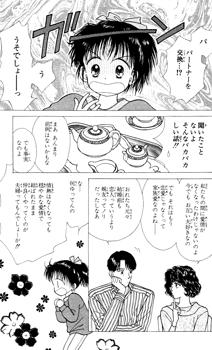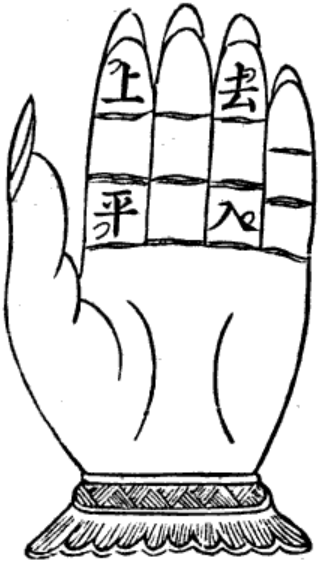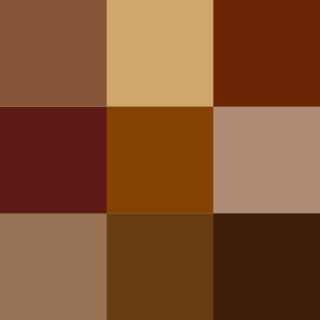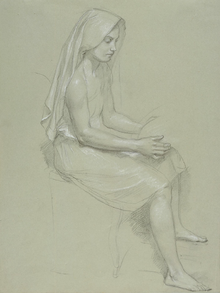
The International Phonetic Alphabet (IPA) is an alphabetic system of phonetic notation based primarily on the Latin script. It was devised by the International Phonetic Association in the late 19th century as a standardized representation of speech sounds in written form. The IPA is used by lexicographers, foreign language students and teachers, linguists, speech–language pathologists, singers, actors, constructed language creators, and translators.
Wade–Giles is a romanization system for Mandarin Chinese. It developed from a system produced by Thomas Francis Wade, during the mid-19th century, and was given completed form with Herbert A. Giles's Chinese–English Dictionary of 1892.

Gouache, body color, or opaque watercolor is a water-medium paint consisting of natural pigment, water, a binding agent, and sometimes additional inert material. Gouache is designed to be opaque. Gouache has a long history, having been used for at least twelve centuries. It is used most consistently by commercial artists for posters, illustrations, comics, and other design work.

Chiaroscuro, in art, is the use of strong contrasts between light and dark, usually bold contrasts affecting a whole composition. It is also a technical term used by artists and art historians for the use of contrasts of light to achieve a sense of volume in modelling three-dimensional objects and figures. Similar effects in cinema, and black and white and low-key photography, are also called chiaroscuro.

Pince-nez is a style of glasses, popular in the late 19th and early 20th centuries, that are supported without earpieces, by pinching the bridge of the nose. The name comes from French pincer, "to pinch", and nez, "nose".

Human physical appearance is the outward phenotype or look of human beings.

A monochrome or monochromatic image, object or palette is composed of one color. Images using only shades of grey are called grayscale or black-and-white. In physics, monochromatic light refers to electromagnetic radiation that contains a narrow band of wavelengths, which is a distinct concept.
The Shanghainese language, also known as the Shanghai dialect, or Hu language, is a variety of Wu Chinese spoken in the central districts of the City of Shanghai and its surrounding areas. It is classified as part of the Sino-Tibetan language family. Shanghainese, like the rest of the Wu language group, is mutually unintelligible with other varieties of Chinese, such as Mandarin.

Jin is a proposed group of varieties of Chinese spoken by roughly 48 million people in northern China, including most of Shanxi province, much of central Inner Mongolia, and adjoining areas in Hebei, Henan, and Shaanxi provinces. The status of Jin is disputed among linguists; some prefer to include it within Mandarin, but others set it apart as a closely related, but separate sister-group.
At right is displayed the color traditionally called liver.
Dark fantasy is a subgenre of fantasy literary, artistic, and cinematic works that incorporate disturbing and frightening themes of fantasy. It often combines fantasy with elements of horror, possessing a dark and gloomy tone or an atmosphere of horror and dread.

Tone mapping is a technique used in image processing and computer graphics to map one set of colors to another to approximate the appearance of high-dynamic-range (HDR) images in a medium that has a more limited dynamic range. Print-outs, CRT or LCD monitors, and projectors all have a limited dynamic range that is inadequate to reproduce the full range of light intensities present in natural scenes. Tone mapping addresses the problem of strong contrast reduction from the scene radiance to the displayable range while preserving the image details and color appearance important to appreciate the original scene content.
A checked tone, commonly known by the Chinese calque entering tone, is one of the four syllable types in the phonology of Middle Chinese. Although usually translated as "tone", a checked tone is not a tone in the phonetic sense but rather a syllable that ends in a stop consonant or a glottal stop. Separating the checked tone allows -p, -t, and -k to be treated as allophones of -m, -n, and -ng, respectively, since they are in complementary distribution. Stops appear only in the checked tone, and nasals appear only in the other tones. Because of the origin of tone in Chinese, the number of tones found in such syllables is smaller than the number of tones in other syllables. Chinese phonetics have traditionally counted them separately.
Exposure compensation is a technique for adjusting the exposure indicated by a photographic exposure meter, in consideration of factors that may cause the indicated exposure to result in a less-than-optimal image. Factors considered may include unusual lighting distribution, variations within a camera system, filters, non-standard processing, or intended underexposure or overexposure. Cinematographers may also apply exposure compensation for changes in shutter angle or film speed, among other factors.

Japanese manga has developed its own visual language or iconography for expressing emotion and other internal character states. This drawing style has also migrated into anime, as many manga stories are adapted into television shows and films. While this article addresses styles from both types of output, the emphasis here is on the manga origins for these styles.

Theatrical makeup is makeup that is used to assist in creating the appearance of the characters that actors portray during a theater production.
The Naʼvi language is a fictional constructed language originally made for the 2009 film Avatar. In the film franchise, the language is spoken by the Naʼvi, a race of sapient humanoids indigenous to the extraterrestrial moon Pandora. The language was created by Paul Frommer, a professor at the USC Marshall School of Business with a doctorate in linguistics. Naʼvi was designed to fit moviemaker James Cameron's conception of what the language should sound like in the film. It had to be realistically learnable by the fictional human characters of the film and pronounceable by the actors, but also not closely resemble any single human language.

The four tones of Chinese poetry and dialectology are four traditional tone classes of Chinese words. They play an important role in Chinese poetry and in comparative studies of tonal development in the modern varieties of Chinese, both in traditional Chinese and in Western linguistics. They correspond to the phonology of Middle Chinese, and are named even or level, rising, departing or going, and entering or checked. They are reconstructed as mid, mid rising, high falling, and mid with a final stop consonant respectively. Due to historic splits and mergers, none of the modern varieties of Chinese have the exact four tones of Middle Chinese, but they are noted in rhyming dictionaries.
The Fuqing dialect, or Hokchia, is an Eastern Min dialect. It is spoken in the county-level city of Fuqing, China, situated within the prefecture-level city of Fuzhou. It is not completely mutually intelligible with the Fuzhou dialect, although the level of understanding is high enough to be considered so.

Shades of brown can be produced by combining red, yellow, and black pigments, or by a combination of orange and black—illustrated in the color box. The RGB color model, that generates all colors on computer and television screens, makes brown by combining red and green light at different intensities. Brown color names are often imprecise, and some shades, such as beige, can refer to lighter rather than darker shades of yellow and red. Such colors are less saturated than colors perceived to be orange. Browns are usually described as light or dark, reddish, yellowish, or gray-brown. There are no standardized names for shades of brown; the same shade may have different names on different color lists, and sometimes one name can refer to several very different colors. The X11 color list of web colors has seventeen different shades of brown, but the complete list of browns is much longer.











